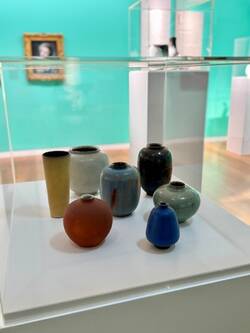After the museum's foundation in 1902 and during the first half of the 20th century, the decorative arts were a major focus of the collection, which was expanded through acquisitions and major gifts, such as the gift of Emmy Weyerbusch's extensive ceramic collection in 1910. Removals and bombing during the Second World War greatly reduced the collection. After the war, the collection was rebuilt, but never to the same size or importance. Today, the Von der Heydt Museum has around 250 works, mainly textiles, ceramics, porcelain and glass.
Arts and Crafts generally refers to the design and manufacture of everyday objects that are functional as well as aesthetically and artistically pleasing, often at the interface between art, design and craftsmanship. A disproportionate number of craft objects are made by women artists. In Western art history, the decorative arts have long been distinguished from the so-called 'high arts' of painting and sculpture. Arts and crafts were considered more appropriate for women or 'typically feminine'. The new publication "Women's Art. From Female Craftsmanship to Feminist Avant-Garde', which can be found in the Knowledge section of this exhibition.
A selection of ceramic vases, all made around 1950 and all purchased, are displayed on two plinths: The three vases with thick, pastose and superimposed glaze gradients are characteristic works by Düsseldorf ceramic artist Waltraud Eich. Eich created over 3,000 objects, which she exhibited internationally.
She trained in the workshop of Richard Bampi, a ceramic artist from southern Germany, whose small blue vase is on the other plinth. Three ceramic vases in light grey, light blue and black were made by the German sculptor and ceramist Otto Lindig. After training in Pößneck and Ilmenau, Lindig studied at the Kunstgewerbeschule and Hochschule für Bildende Kunst in Weimar from 1913 under Henry van de Velde, among others. From 1920 he made his mark at the Bauhaus, where he worked in the Dornburg ceramics workshop under Gerhard Marcks, developing prototypes for serial ceramics and designing tableware for well-known manufacturers. After the Weimar Bauhaus closed in 1925, he ran the Dornburg workshop and worked as a teacher until 1947. Lindig later headed the ceramics department at the Landeskunstschule in Hamburg.
Two local artists are also represented on the pedestal: The spherical terracotta vase is by Hellmuth Grüttefien, a sculptor and ceramicist from Wuppertal who, in addition to his ceramic work, also created public art in Wuppertal. The collection includes several vases by Grüttefien as well as by Trude Bilstein. Born in Ennepetal in 1914, she studied at the Kunstgewerbeschule in Stuttgart and completed her Masters degree in Landshut. She opened her own studio in Wuppertal-Cronenberg in 1948.


